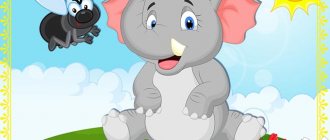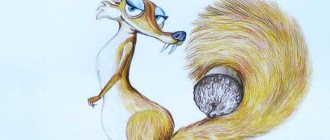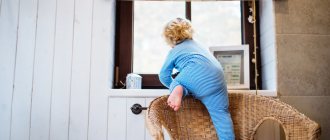Summary of a lesson on theatrical activities in the senior group “We are learning to be actors”
Goals:
Encourage children to improvise using available means of expression (gestures, facial expressions, movements);
Develop imagination, the ability to independently play out, first in the mind and then in action, a chain of given movements;
Encourage children, with the help of gestures, facial expressions, and movements, to strive to create a holistic artistic image;
Develop the articulatory apparatus, facial abilities;
Foster a love of theater and a culture of communication.
Previous work:
• Work on the fairy tale “The Three Bears”: retelling, analyzing the character and appearance of the characters, drawing illustrations for the fairy tale.
• Carrying out articulation gymnastics complexes.
• Carrying out transformation games “Guess who I am?”, “Do as I do”, “The sea is agitated once...”
Equipment and inventory:
• Masks-caps of three bears;
• Furniture and dishes for staging an excerpt from the fairy tale “The Three Bears”;
• Fake apple.
Progress of the lesson:
Educator: Guys, which of you was in the theater? (Children's answers) What is theater? Why do people need theater? (Children's answers) (sums up what they heard: “At all times, people came to the theater to relax. They come there with their family, with friends. The theater helps people to be kinder and better. A fairy tale lives in the theater.) And today in our lesson we will try to learn become a little bit of an actor.
Educator: First, we will train our face so that it can depict all our feelings. I will turn you into gnomes.
I spin my magic wand
I'm turning you all into gnomes.
Gnomes, look in the mirror,
Everyone have fun! (Children depict joy and fun)
Come on, stop having fun,
You all need to get angry! (Children pretend to be angry)
Well, you can't be angry forever,
I suggest you be surprised! (Children feign surprise)
And such entertainment:
Show disappointment. (Children pretend to be upset)
Educator: Well done, you trained well. Why don’t we watch some unusual fairy tale now? It will be unusual because you will not utter a single word. Only I will speak, you will show what I say. Are you ready to create a fairy tale together? (Ready.) Let's begin!
Fairytale-pantomime “Bunny and the Hedgehog”.
Educator: The sun is shining brightly. The teacher invites the performer to play the role of the Sun. The sun begins to “shine brightly” with all its might - it spreads its arms to the sides, puffs out its cheeks, opens its eyes wide, and spins in place.
Educator: Suddenly the wind blew. Two or three children play the role of the Wind - they run out and blow hard on the Sun.
A small cloud ran into the sun. A girl runs out and blocks the Sun.
The wind blew stronger, and leaves began to fly off the trees. (Children pretend to be trees.) A bunny ran up to the tree. (The Bunny appears.) He stood on his hind legs and cheerfully waved his ears. A hedgehog approached the bunny. There was a nice apple sitting on its thorns. (The Hedgehog comes out, holding a fake apple in his hands.) The Hedgehog treated the bunny. At this time the first snow fell on the ground. (Snowflake girls perform a dance.) Cheerful snowflakes swirled in the air and landed on the ground. Soon the snow covered the hare and the hedgehog. (The Snowflake Girls close a circle around the Hare and the Hedgehog.) But then the sun came out again. (Tuchka Girl runs away from the Sun). It shone brightly, brightly. (The sun “directs its rays” to the Snowflakes.) And the snowflakes melted. And the friends, freed from the snow, shook themselves off, rejoiced at the sun, jumped up and ran each their own way. The Hare and the Hedgehog leave to the music, waving their paws to the guys goodbye.
Educator: Guys, we acted out a fairy tale. The heroes of the fairy tale did not say a word, they performed everything in silence. Such a game on stage is called pantomime - it is a game without words, in which only gestures and facial expressions are used - facial movements and body movements.
It's no secret that artists must be able to speak well, clearly, beautifully. To do this, we will train our tongues. Let's say the magic words: “Choki-choki-choki-chok!” Work your tongue!”
Articulation gymnastics.
1. "Swing". The mouth is slightly open. With the tip of the tongue we touch either the upper or the lower lip.
2. "Watch". The mouth is slightly open. Using the tip of your tongue, alternately touch the left and right corners of your lips.
Educator: And artists must breathe correctly and be able to speak both loudly and quietly. Let's practice together.
Game "Beep"
Children stand in a row facing the teacher and raise their arms up from their sides, touching with their palms, but do not clap. Then slowly lower it down through the sides. Simultaneously with lowering their hands, children pronounce the sound “U”, first loudly, and then gradually more and more quietly. They lower their hands and fall silent. First, the teacher himself shows the actions, then calls two children who perform the actions together with him and make a sound, the rest of the children only make movements with their hands. Then all the children play.
Educator: Well done everyone! Now let's try to act out a scene from the fairy tale “The Three Bears” that you know. And now we will not only portray the main characters, but also speak for them in different voices. (roles are assigned, bear masks are put on). Let's think about how to show Papa Bear Mikhailo Ivanovich. What kind of character do you think he has? (He is strict, has a very loud voice, big, waddles, angry). And Nastasya Petrovna? (She speaks in a not very loud voice, kind). What kind of Mishutka? (His voice is squeaky, he is touchy, upset, walks with small steps, and has a club foot). Now we will arrange the furniture and dishes.
Dramatization of an excerpt from the fairy tale “The Three Bears”
And the bears came home hungry and wanted to have dinner. The big bear took his cup, looked and roared in a terrible voice:
- Who drank in my cup?
Nastasya Petrovna looked at her cup and growled not so loudly:
- Who drank in my cup?
And the bear saw his empty cup and squeaked in a thin voice:
- Who sipped in my cup and drank it all up?
Mikhailo Ivanovich looked at his chair and growled in a terrible voice:
-Who was sitting on my chair and moved it from its place?
Nastasya Petrovna looked at her chair and growled not so loudly:
-Who was sitting on my chair and moved it from its place?
Mishutka looked at his broken chair and squeaked:
-Who sat on my chair and broke it?
The bears came to another room.
“Who lay in my bed and rumpled it?” - Mikhailo Ivanovich roared in a terrible voice.
“Who lay in my bed and rumpled it?” - Nastasya Petrovna growled not so loudly.
And Mishenka put up a little bench, climbed into his crib and squeaked in a thin voice:
- Who went to bed with me?
And suddenly he saw the girl and screamed as if he was being cut:
- Here she is! Hold it, hold it! Here she is! Here she is! Ay-yay! Hold it!
He wanted to bite her. The girl opened her eyes, saw the bears and rushed to the window. The window was open, she jumped out the window and ran away. And the bears did not catch up with her.
Educator: Well, did you like our performance? Spectators can clap for our artists! Now let's remember what we did today? I turned you into gnomes, why? We trained the face to show different emotions and feelings. We did gymnastics for the tongue and voice to learn to speak clearly and be able to control our voice. We showed a pantomime fairy tale. How did we show it? Without words, only with hands, face, dancing. And we also acted out a scene from the fairy tale “The Three Bears,” where we portrayed a family of bears in different voices and movements. Well done, you have already become a bit of an actor today!
REFERENCES:
1. Games to develop emotions and creativity. Theater classes for children 5-9 years old. – St. Petersburg. : Speech; M.: Sfera, 2011.
2. Theatrical activities in kindergarten: A manual for employees of preschool institutions. - M.: Sphere shopping center, 2001.
3. Development of the emotional-motor sphere of children 4-7 years old: recommendations, educational games, sketches, exercises, classes / author. - comp. . – Volgograd: Teacher, 2013.
4. Theater activities in kindergarten. For classes with children 5-6 years old. - M.: Mosaika-Sintez, 2008.
Get text
Conversation on the topic “Getting to know the theater” with children of the senior group
DRAMA THEATER
In a drama theater, actors are talking. The playwright talks about the characters and events in the play through dialogues.
THEATER OF BEASTS
The oldest theater exists in Moscow - the theater of V. L. Durov. “Grandfather Durov’s Corner”, where animals perform: hippopotamus, elephant, raven, pelican, raccoon and many others.
PUPPET SHOW
There are puppet theaters where spectators look not at live performers, but at puppets controlled by the performers: glove dolls, marionette dolls, shadow theater.
AUDITORIUM
Let's take a look at the auditorium. The most important place in the auditorium is the stage on which the performance is performed. The scene itself is not yet visible. It is still closed with a curtain. If you are sitting far from the stage, you will need theater binoculars, which you can bring with you or purchase from the cloakroom.
PARTERRE, BENOIR, MENS ELECTA, 1st LEVEL, 2ND LEVEL, BALCONY
ORCHESTRA PIT. Musical operas and ballets, in opera the artists sing, they are called soloists, and they are assisted by choreographers and an orchestra. The orchestra is led by a conductor so that the musicians play in the same rhythm and tempo, and in ballet the artists dance. A choreographer helps them in staging the dance. The musicians are sitting in the orchestra pit. The orchestra pit is a special room for the orchestra in the theater, located in front of the stage.
A CURTAIN. What is a theater curtain? This is a canvas that covers the stage from the audience. The performance will begin as soon as the curtain rises or moves apart, as they are sliding or rising.
SCENERY. The scenery for the performance is made in the workshop according to the sketches of the decorative artists. The scenery for the performance is made in the painting and decoration workshop according to the artists’ sketches.
PROPS. Props are fake, specially made objects of sculpture, furniture, and dishes used in theatrical performances instead of real things. A theater worker who makes props is called a prop maker. Crockery, food, weapons, and furniture can be props.
SPOTS. With the help of spotlights, lighting designers can depict sunrise or sunset, flashes of lightning, starry skies and much more on stage.
During a performance, a sound operator can turn on a soundtrack: the sound of rain or the roar of waves, the roar of a crowd or the whistle of the wind - depending on what is happening on stage at that time.
MAKE-UP MAKER. Before the performance, the make-up artist applies makeup to the actors. An experienced master can change an actor's face beyond recognition. Actors for a performance may need a variety of costumes - ancient, modern, and even fairy-tale.
The entire costume must first be designed and then drawn by the artist. The tailors will then bring his ideas to life. Masters can paint a piece of burlap in such a way that from the audience it will seem like rich brocade, velvet or silk.






